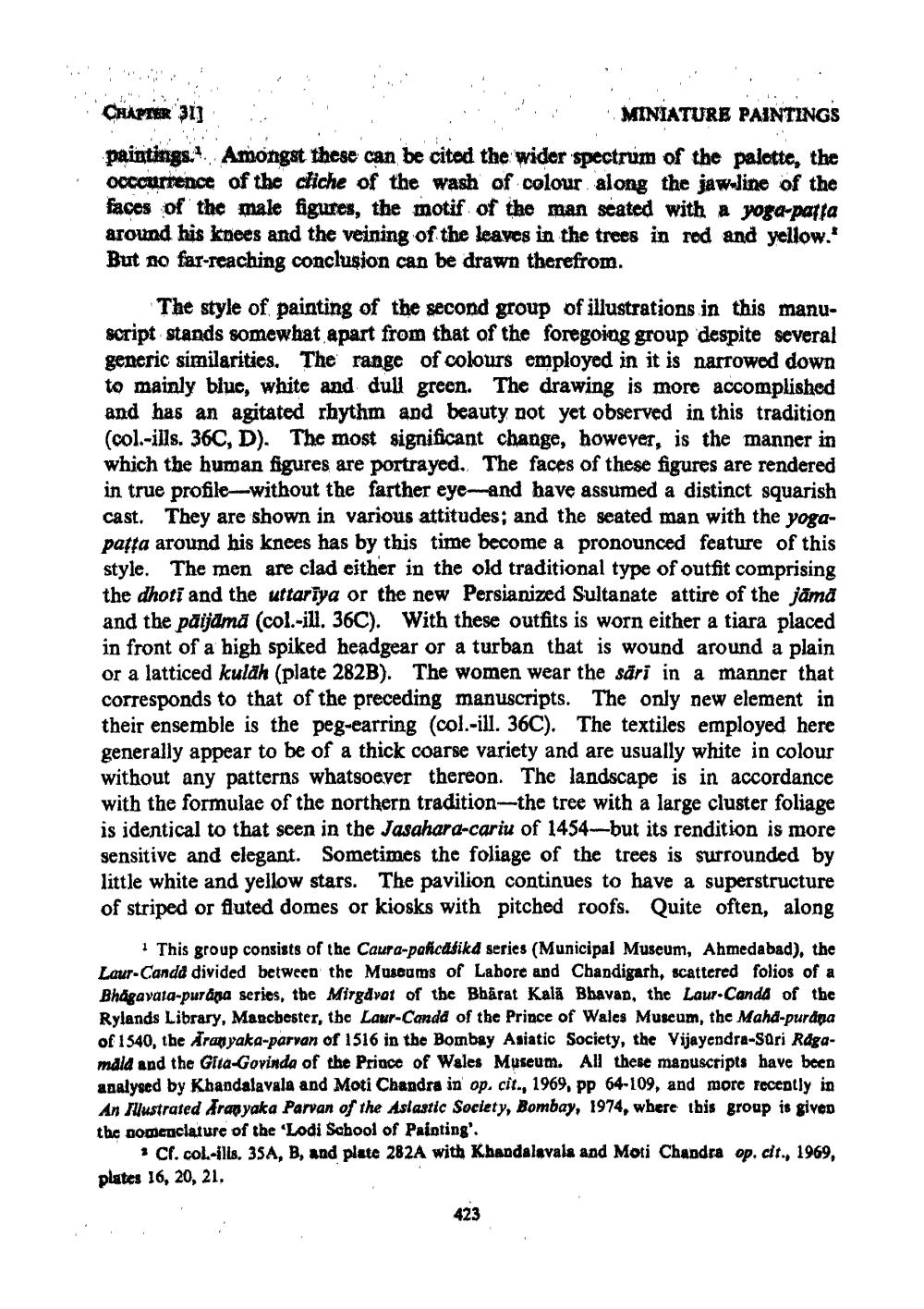________________
CHAPTER 311
MINIATURE PAINTINGS
paintings. Amongst these can be cited the wider spectrum of the palette, the occcurrence of the cliche of the wash of colour along the jaw-line of the faces of the male figures, the motif of the man seated with a yoga-patta around his knees and the veining of the leaves in the trees in red and yellow." But no far-reaching conclusion can be drawn therefrom.
The style of painting of the second group of illustrations in this manuscript stands somewhat apart from that of the foregoing group despite several generic similarities. The range of colours employed in it is narrowed down to mainly blue, white and dull green. The drawing is more accomplished and has an agitated rhythm and beauty not yet observed in this tradition (col.-ills. 36C, D). The most significant change, however, is the manner in which the human figures are portrayed. The faces of these figures are rendered in true profile-without the farther eye-and have assumed a distinct squarish cast. They are shown in various attitudes; and the seated man with the yogapatta around his knees has by this time become a pronounced feature of this style. The men are clad either in the old traditional type of outfit comprising the dhoti and the uttariya or the new Persianized Sultanate attire of the jama and the paijāmā (col.-ill. 36C). With these outfits is worn either a tiara placed in front of a high spiked headgear or a turban that is wound around a plain or a latticed kuläh (plate 282B). The women wear the säri in a manner that corresponds to that of the preceding manuscripts. The only new element in their ensemble is the peg-earring (col.-ill. 36C). The textiles employed here generally appear to be of a thick coarse variety and are usually white in colour without any patterns whatsoever thereon. The landscape is in accordance with the formulae of the northern tradition-the tree with a large cluster foliage is identical to that seen in the Jasahara-cariu of 1454-but its rendition is more sensitive and elegant. Sometimes the foliage of the trees is surrounded by little white and yellow stars. The pavilion continues to have a superstructure of striped or fluted domes or kiosks with pitched roofs. Quite often, along
1 This group consists of the Caura-pañcášikd series (Municipal Museum, Ahmedabad), the Laur-Canda divided between the Museums of Lahore and Chandigarh, scattered folios of a Bhagavata-purana series, the Mirgdvat of the Bharat Kali Bhavan, the Laur-Canda of the Rylands Library, Manchester, the Laur-Canda of the Prince of Wales Museum, the Mahd-purāņa of 1540, the Aranyaka-parvan of 1516 in the Bombay Asiatic Society, the Vijayendra-Sari Ragamald and the Gita-Govinda of the Prince of Wales Museum. All these manuscripts have been analysed by Khandalavala and Moti Chandra in op. cit., 1969, pp 64-109, and more recently in An Illustrated Aranyaka Parvan of the Aslastic Society, Bombay, 1974, where this group is given the nomenclature of the 'Lodi School of Painting'.
* Cf. col-ills. 35A, B, and plate 282A with Khandalavala and Moti Chandra op. cit., 1969, plates 16, 20, 21,
423




